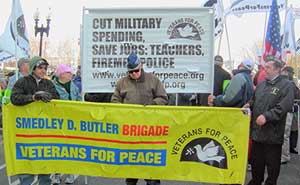‘Peace parade’ challenges Boston status quo
Published Apr 1, 2011 8:02 PM
By Steve Gillis
Vice President, Boston School Bus Drivers
Steelworkers union Local 8751
Nearly 1,000 marchers, led by the Smedley D. Butler Brigade of Veterans for
Peace, withstood chilly winds and South Boston’s bitter history of racism
and anti-lesbian/gay/bi/trans/queer discrimination when they conducted a
“Peace Parade” through South Boston’s neighborhoods on March
20. They marched one mile behind the official St. Patrick’s Day parade,
which had many military and ROTC contingents.
With the backing of the U.S. Supreme Court, the official parade has legally
banned anti-war and LGBTQ groups from participating. In 1992 the Irish American
Gay, Lesbian and Bisexual Group of Boston formed a contingent in the parade,
but it was met with bigotry, epithets, jeers, snowballs, bottles and a lawsuit
by the Allied War Veterans Council, claiming the right of “private”
parade sponsors to discriminate against anyone they choose. The Supreme Court
infamously upheld that in 1995.
This year Vets for Peace applied and fought for a separate march permit for the
same day and the same streets. They won this right in local courts, declared it
a victory in the struggle against discrimination, and invited all LGBTQ groups,
anti-war organizations and unions to take back the streets of South Boston with
them in a Peace Parade.
Pat Scanlon, a Vietnam War veteran and coordinator of the Greater Boston
Chapter of Veterans For Peace, courageously led the Peace Parade onto Broadway
Street and into the crowds of revelers. Marchers included Vets for Peace,
several LGBTQ rights groups, anti-war activists and unionists from the Service
Employees, Steelworkers and American Federation of State, County and Municipal
Employees. They chanted and demanded an end to the wars; bring the troops home
now; money for human needs, not war; and an end to anti-LGBTQ bigotry. They
strutted to the sound of their own marching band and to the School Bus
Drivers’ sound truck blasting the Street Dogs’ “Power in the
Union!”
While there were some slurs and other invectives displayed toward the peace
marchers, the vast majority lining the streets and on their porches loudly and
enthusiastically cheered the Peace Parade’s contingents and message.
Hundreds jumped police lines to dance and march with the officially banned
vets. Spectators planted hugs and green-beaded necklaces on the
rainbow-festooned marchers, many of whom were carrying placards denouncing the
bombing of Libya. Fists in the air greeted the union folks bringing up the rear
flank with signs proclaiming “We Stand With Wisconsin Workers” and
“Stop School Closings!”
If the war establishment was counting on support and backlash from the old
South Boston, they were likely deeply disappointed by the display of unity and
solidarity marching, chanting, singing and dancing up Broadway Street.
Articles copyright 1995-2012 Workers World.
Verbatim copying and distribution of this entire article is permitted in any medium without royalty provided this notice is preserved.
Workers World, 55 W. 17 St., NY, NY 10011
Email:
[email protected]
Subscribe
[email protected]
Support independent news
DONATE


